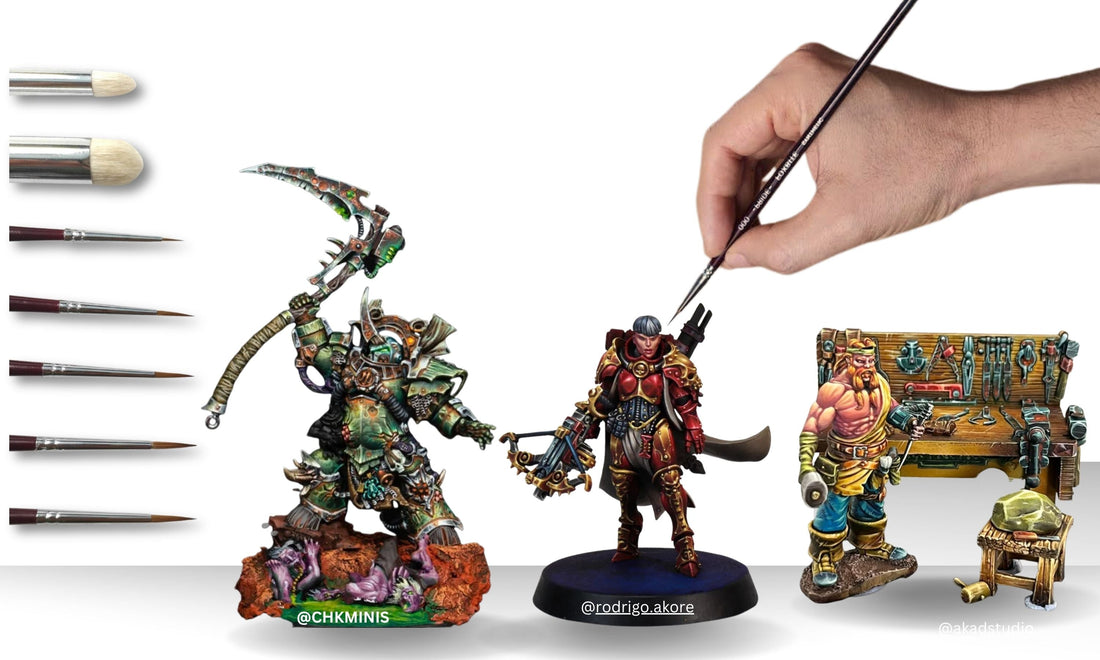
How to Clean and Maintain Miniature Painting Brushes (Kolinsky Sable and Synthetic)
Share
How to Clean and Maintain Miniature Painting Brushes (Kolinsky Sable and Synthetic)
Cleaning Basics
-
Rinse immediately after use
Prevents acrylic from drying inside the bristles. Dried paint hardens and breaks fibers near the ferrule, permanently reducing precision. -
Use lukewarm or cool water
Hot water softens the adhesive inside the ferrule, causing hairs to loosen and the ferrule to detach over time. -
Apply mild brush soap and clean from ferrule to tip
Keeps paint from building near the ferrule and preserves the natural taper of the bristles. Scrubbing in reverse direction bends or frays the hairs. -
Rinse until water runs completely clear
Residual pigment continues to dry between hairs and shortens brush life, even if not visible. -
Reform the tip while damp and let dry horizontally or tip down
Keeps the natural point and prevents water from seeping into the ferrule, where it can swell the wooden handle and loosen the glue.
Kolinsky Sable Brushes
-
Clean after each session with dedicated brush soap
Removes pigment and medium without stripping natural oils from the hair. Regular soaps dry the fibers, making them brittle. -
Deep clean weekly with professional brush cleaner
Dissolves pigment particles trapped inside the belly of the brush. If left, they stiffen and cause splitting. -
Avoid prolonged soaking or exposure to heat
Water and heat soften the resin that bonds the hairs. This leads to loose bristles and deformation of the brush head. -
Apply a trace of hair conditioner occasionally
Maintains flexibility and restores the natural coating of oils that keep the Kolinsky hair elastic. Without it, the brush becomes dry and loses snap. -
Reshape the tip while damp
Prevents irregular drying that can twist or flare the bristles, keeping the brush aligned for fine detail work. -
Breaking in a new Kolinsky brush
A new brush may show a few fine stray hairs or a slightly uneven tip. This is normal. After 5 to 10 uses, the hairs align naturally and the point becomes perfectly sharp. Do not trim the tip regular use and cleaning will refine it.
Synthetic Brushes
-
Clean with mild soap and rinse thoroughly
Synthetic fibers can trap micro-residues that harden. Proper rinsing prevents stiffness and tip curling. -
Avoid solvents and high temperatures
Solvents break down the synthetic polymer coating. Heat causes permanent warping or melting of fibers. -
Reform the tip and air dry completely
Keeps uniform alignment. Storing while wet allows moisture inside the ferrule, weakening the joint and growing mold.
Storage
-
Store horizontally or with the tip facing down
Prevents residual water from seeping into the ferrule, which can swell the wood and cause cracking. -
Use caps or sleeves to protect bristles
Avoids bending or contamination that affects precision when dry. -
Keep brushes in a dry, ventilated area
Reduces risk of mold and corrosion on metal ferrules.
Avoid
| Practice | Why it Damages the Brush |
|---|---|
| Letting paint dry near the ferrule | Dried pigment cements the hairs together and breaks them when flexed |
| Using hot water | Loosens ferrule glue and causes bristles to fall out |
| Long soaking | Swells wooden handles and weakens bonding resin |
| Rough scrubbing | Frays bristles and destroys the natural tip shape |
| Leaving brushes upright with wet tips | Moisture collects inside ferrule, rotting glue and rusting metal |
